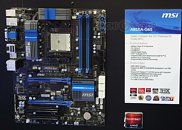- Joined
- Oct 9, 2007
- Messages
- 47,668 (7.43/day)
- Location
- Dublin, Ireland
| System Name | RBMK-1000 |
|---|---|
| Processor | AMD Ryzen 7 5700G |
| Motherboard | Gigabyte B550 AORUS Elite V2 |
| Cooling | DeepCool Gammax L240 V2 |
| Memory | 2x 16GB DDR4-3200 |
| Video Card(s) | Galax RTX 4070 Ti EX |
| Storage | Samsung 990 1TB |
| Display(s) | BenQ 1440p 60 Hz 27-inch |
| Case | Corsair Carbide 100R |
| Audio Device(s) | ASUS SupremeFX S1220A |
| Power Supply | Cooler Master MWE Gold 650W |
| Mouse | ASUS ROG Strix Impact |
| Keyboard | Gamdias Hermes E2 |
| Software | Windows 11 Pro |
MSI showed off its top socket FM2 motherboard, the A85XA-G65. Based on the AMD A85 FCH chipset, the board supports upcoming AMD "Trinity" APUs in the FM2 package. MSI designed the A85XA-G65 with its Military Class III construction. The FM2 APU is powered by an 8-phase VRM. It is wired to four DDR3 DIMM slots, supporting dual-channel DDR3-1866 MHz memory; and two PCI-Express 2.0 x16 slots (x8/x8, when both are populated). Given that it supports both NVIDIA SLI and AMD CrossFire, it's a little strange that MSI didn't name this model "A85XA-GD65." Other expansion slots include three PCI-Express 2.0 x1 and two legacy PCI.
All eight SATA 6 Gb/s ports from the A85 FCH are wired out as internal ports, with no eSATA. Display outputs include one each of DVI, D-Sub, HDMI, and DisplayPort. Other connectivity options include four USB 3.0 ports, gigabit Ethernet, and 8+2 channel HD audio. The A85XA-G65 features quite a few OC-friendly features, including voltage-measurement points with lead-holders, OC Genie, ClickBIOS II UEFI BIOS, etc. It will be among MSI's first socket FM2 motherboards to be launched, a little later this quarter.

View at TechPowerUp Main Site
All eight SATA 6 Gb/s ports from the A85 FCH are wired out as internal ports, with no eSATA. Display outputs include one each of DVI, D-Sub, HDMI, and DisplayPort. Other connectivity options include four USB 3.0 ports, gigabit Ethernet, and 8+2 channel HD audio. The A85XA-G65 features quite a few OC-friendly features, including voltage-measurement points with lead-holders, OC Genie, ClickBIOS II UEFI BIOS, etc. It will be among MSI's first socket FM2 motherboards to be launched, a little later this quarter.

View at TechPowerUp Main Site



